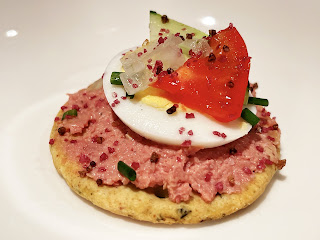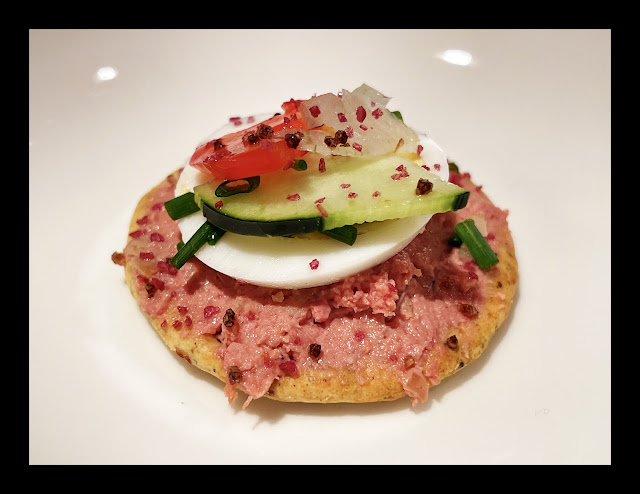Bubbe’s Chopped liver {Sous-Vide}
What am I, chopped Liver? When I think of chopped Liver, I have four connections or rather memories. One fond memory was my Mom and Bubbe (Yiddish for Grandmother) making Chopped Liver. The second memory took place with my buddy RC. My buddy and I went to Seattle for an excursion, and we had an inkling for some Classic Jewish Chopped Liver. We found a great place that served quintessentially profound Jewish Food. Oh, man, that opened a floodgate of fond memories. The third memory, of course, was the Jewish Deli I grew up with in NYC.
My other Bubbe was not a cook at all. When I was ten, she decided to make some beef tongue, stereotypical Jewish deli meat. It was my first (that I know of) introduction to beef tongue. She boiled it for who knows how long and tossed it on a plate. She did not attempt to disguise what we were about to eat, nor did she appear to care either. Taste buds and all were intact too!! To say it did not look appetizing is an understatement. I refused to eat it, and she cried. That was 1975, and although that was a bad memory, I've made my share of Tongue Pastrami and Corned Beef.
The last one is the phrase or idiomatic expression many have heard. What am I Chopped Liver? The origins could be clearer, but I have discovered a few theories that make sense. Most people that buy whole chickens toss out the heart, gizzards, and Liver, putting them at the bottom of what is desirable. Disposable and not necessary come to mind. So What am I? Chopped Liver could mean that they are less sought after than others. And let's remember Chopped Liver is always served as a side dish/Appetizer, not the main course. So what am I? Chopped Liver can be intercepted as disposable and not necessary. Have you ever felt like a side dish?
Unless they have eaten stereotypical Jewish food or grown up around Jewish Delis, some of these ingredients might seem foreign. I also added an ingredient that will have some shaking their heads.
Using the word Chopped in the title is a stretch because my version is smooth compared to traditional ones found in Delis or your Bubbes house. Of course, this is my preference, but it can be modified if you endeavor to replicate the recipe. I prefer to schmear to a plop 🤣🤣. My Mom and Grandmother did not have access to a food processor or grinder, so everything was done with a knife. You can change the texture by using different methods to process, i.e., a grinder or a sharp knife.
Let's discuss the recipe, ingredients, and processing before proceeding.
Sous-Vide vs. other Cooking methods? If you've Sous-Vide before, you already know the answer. Sous-Vide gives you precision and consistent results every time. The added benefit of pasteurization and using mason jars give you extended shelf life under refrigeration.
The percentages are in relation to the weight of the Chicken Livers for easy replication and specificity. I.e., 1000 grams of chicken livers would need 12.5 g of Salt at 1.25%. 1000 x 1.25% (or 0.0125) = 12g. Why am I so precise? Some people like precision for replication purposes. I wing it most of the time because I've done it many times before. I will give a sample recipe below.
Note: Eggs weigh between 5 and -55 grams; this should help you estimate how many large eggs you need.Remember most recipes are just guidelines.
Why use Cure #1? This is a secret ingredient that some delis use to preserve the color and extend shelf life and eliminate pathogen proliferation such as Botulism. It's entirely optional. And I like the color and taste too.
What is Schmaltz and Gribenes? Schmaltz is rendered Chicken fat, and the by-product is what we call Gribenes or cracklings to some. It is (for me) the quintessential stereotypical ingredient in everything Jewish. To me, it's liquid GOLD. I often use it in place of butter in many dishes. At any given time, I have about a quart of Schmaltz and about a one-gallon bag of Gribenes on hand. I store them in the freezer. Can you make this without them? Yes, but it won't taste the same.
Clean the livers by trimming, scraping, and discarding any visible fat, blood, green parts, or membrane. How to clean chicken livers..... see the link.
Place the livers in a large bowl with water and agitate the livers to get off all residual blood and debris. Contrary to popular belief, you can not cook out blood!!! Anyhow pour out the water and repeat at least 3x or until satisfied. Now place livers in a sieve in the sink and, using a spray nozzle rinse several times. Let them drain into another bowl. Check the bowl the liver drained into. You are looking for primarily clear water. There's a lot of stuff on livers that cannot be seen with the naked eye. Drain very well.
Measure out the Salt, Pepper, and Cure #1 and mix well. Place livers in another bowl and toss on the Salt/Cure mixture and mix well. Place in the refrigerator until you are ready for the next step.
Measure out your onions, Schmaltz salt, and pepper.
Toss Schmaltz (mine is always frozen) in the pan and heat up before adding onions. Add onions, Salt, and pepper. You want to take it to the translucent stage.
Note: My measurements on not very critical, but they are there to help you gauge what you need. I used a very large onion, some salt, and pepper.
Measure out the Gribines and, using a food processor, make it into a paste. Add the Gribenes to the pan and stir, making sure it's well combined with onions.
Note: Make sure the Gribenes are frozen before adding them to the food processor. This will make it easier to form into a paste.
Using a food processor, combine the eggs and onion Gribene mixture and process until chunky.
Note 1: At this point, you can change up the texture if you want. Remove and set aside and process the livers separately if you want. And if you really want to customize the texture, consider using a knife to cut gribenes into small pieces.
Note 2: Another option for texture/flavor, which I love, is to broil the liver (better for Kastrut). Schmear some schmaltz on the liver and broil for a bit, then process. Everything is better with schmaltz.
Toss the raw livers into the food processor and give it a whirl. You choose your own texture. I prefer a smooth texture, but I have never done it twice the same way.
Note: Some options to consider for texture. Remove the egg and onion mixture and set aside. Process the livers to your desired texture. In a separate bowl, combine livers with egg and onion mixture.
How to measure for the jars. The jars I used hold 8-oz. Each jar will hold 215 grams. Weigh everything out and compute the jars needed for the amount you have.
Tightening lids- this is from Chef-Steps -Close jars until "fingertip tight" Place the lid on the jar. Twist the lid until "fingertip tight," meaning just barely closed and still possible to open with your fingertips.
To close the jar's fingertip tight, place the lid on top of the jar, then twist the band to tighten using just your fingertips. When you begin to feel resistance, twist once in the opposite direction, then once more in the original direction to tighten.
Closing the jars until fingertip tight means that air will escape from the jars when you submerge them in water. If you close them too tightly, the trapped air will press against the glass and could crack or break your jars.
I processed them at 155f at 2-hours, which ensures pasteurization. After processing, set on a towel on the counter. After about 10-15 minutes, place jars in a very large container and shock with ice-cold water with a huge amount of ice. I also use an aquarium pump to circulate water which will enhance cooling by 30%.
Note: In a few weeks, expect a pasteurization table to reflect a few different jar sizes. I plan on drilling through the top of the mason jar lid, using self-sealing foam tape, and using a probe to monitor the temp.
Sering suggestions- A freaking sandwich, of course.
Crackers topped with egg, cumbers, onions, chives, tomatoes, etc. Use some finishing salt too. I used a Black Truffle salt and a Merlot Sat. I am reducing my gluten intake, so I used GF bread....but oh dear, Rye-Bread is so much better.
Before writing this recipe up, I posted a plethora of pictures and a synopsis of the process. I've never seen so many authenticism evaluations on any given food, not to mention the negativity. I even went as far as to write up an article on this very topic a while back ("The folly of Authenticism and Absolutism with regards to Food" KD).






















Comments
Post a Comment